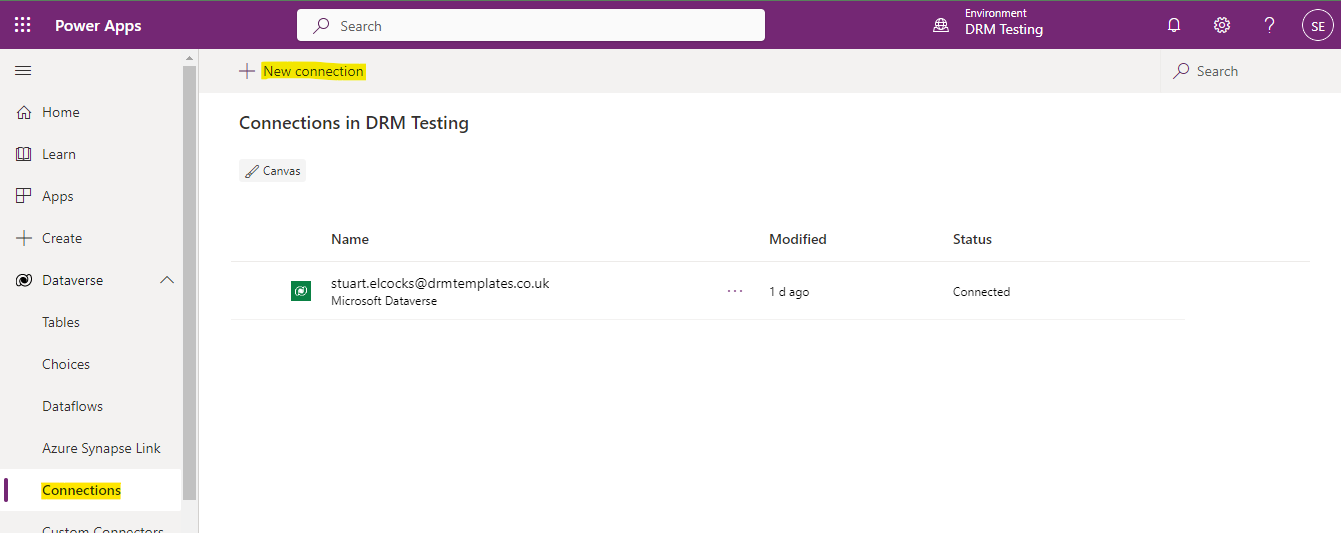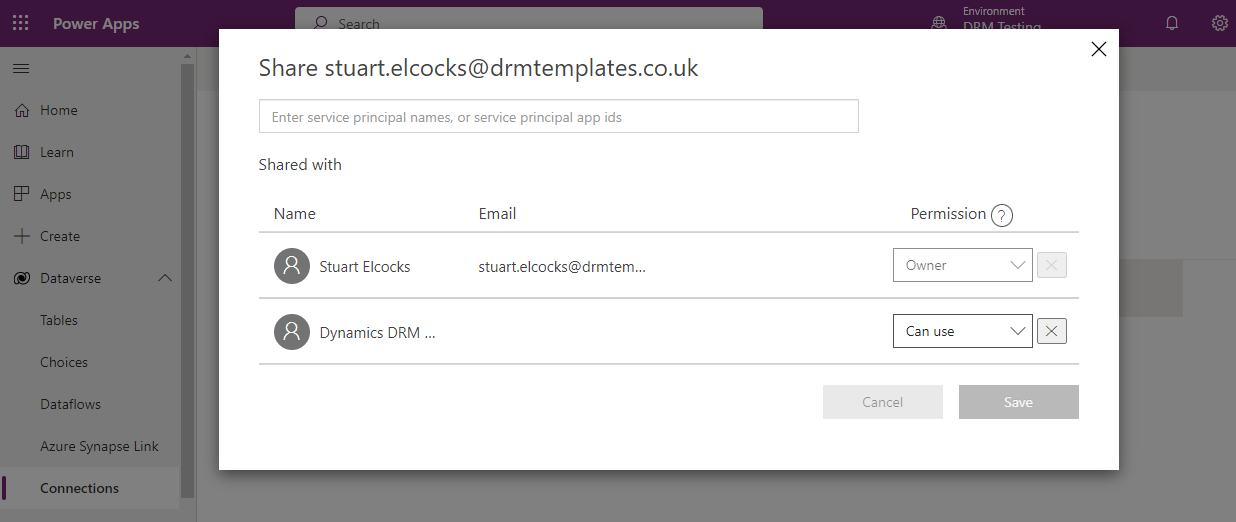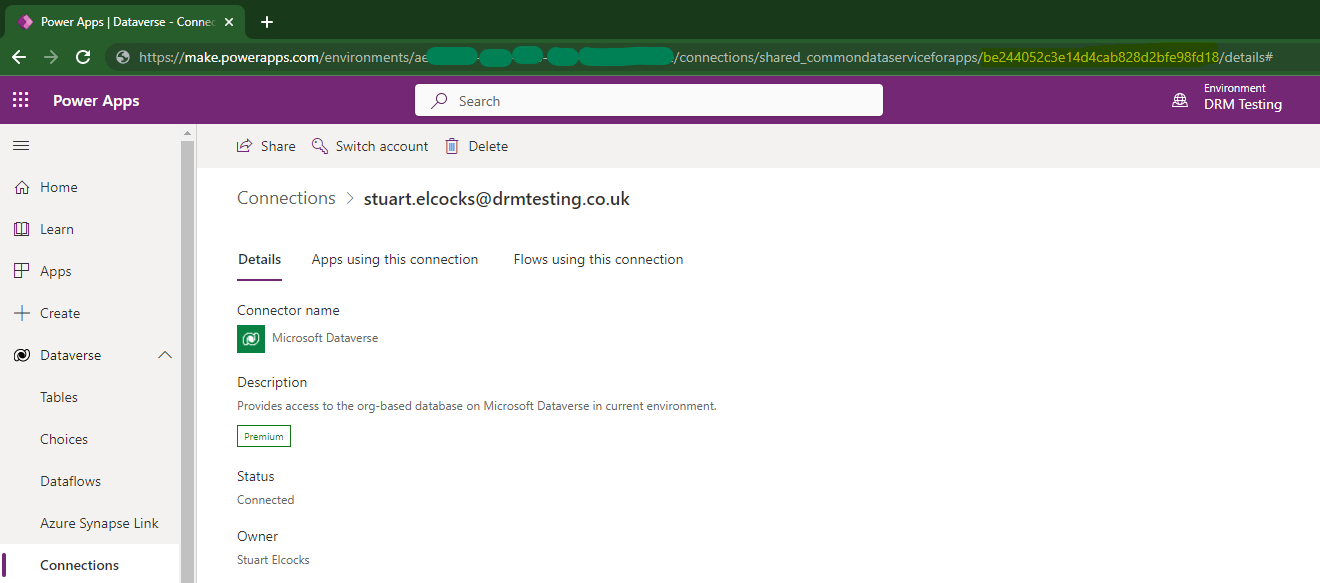Configure Dynamics Connection References
This document focuses on connection references. It is important to note that if the connection itself is not present in the Dynamics environment where the connection reference is being deployed, the reference will fail.
In this example, you will achieve the following
- Create a Microsoft Dataverse connection in your target Dynamics environment.
- Generate a template to update a connection reference with a specific name.
- Deploy the template to complete the connection reference.
Prerequisites
- To deploy the template, you will need a Dynamics environment with system administrator access.
- An application registration used for connecting to your Dynamics environment.
- PowerShell with the DRM module installed. Follow this guide to install the powerhsell module
Create the connection
As a one time step you will need to create the connection in your target Dynamics environment.
In this example we are going to create a 'Microsoft Dataverse' connection.

Once the connection is created we need to share it with the application registration used to deploy the template.

Share the connection with the application registration and select the permission as 'Can use'

Finally lets get the connection id, by clicking on the connection and making a note of the second guid in the url. This is the connection id.

Generate the template
In this example we are going to run the New-DrmTemplate command against the Dynamics
environment we will eventually deploy too. In the real world you would probably generate the
template against a master environment, but the outcome would be the same.
We want to update a specific connection reference with the name of 'Drm Connection Reference'.
Run this command against your environment.
New-DrmTemplate
-entityName connectionreferences
-filter '$select=connectionreferencedisplayname&$filter=connectionreferencedisplayname eq ''Drm Connection Reference'''
-SetupTemplateForAutomation
The template returned would be as below.
Note
This example is for updating one connection reference, adjust the filter to suit your requirements.
{
"$schema": "https://schemas.drmtemplates.io/2021-03-01/deploymentTemplate.json#",
"contentVersion": "1.0.0.0",
"parameters": {
"drmclientId": {
"type": "string",
"defaultValue": "00000000-0000-0000-0000-000000000000"
},
"drmclientSecret": {
"type": "string",
"defaultValue": "00000000-0000-0000-0000-000000000000"
},
"dynamicsTenantId": {
"type": "string",
"defaultValue": "00000000-0000-0000-0000-000000000000"
}
},
"resources": [
{
"targetenvironment": {
"applicationCredentials": {
"clientId": "[parameters('drmclientId')]",
"clientSecret": "[parameters('drmclientSecret')]",
"tenantId": "[parameters('dynamicsTenantId')]"
},
"url": "<Your dynamics url>"
},
"type": "drm.crmbaseentity/connectionreferences",
"apiVersion": "2023-01-09",
"name": "GeneratedTemplateFor_connectionreferences",
"properties": {
"data": [
{
"connectionreferenceid": "a14ada61-aa5b-ab12-acda-a5a9f14e7f94",
"connectionreferencedisplayname": "Drm Connection Reference"
}
]
}
}
]
}
For this exercise populate the defaultValue for drmclientId,
drmclientSecret and dynamicsTenantId. Also make sure the url
property is correct.
Deploying the template
Before deploying the template we need to add a property to our generated template that will update the connectionreference to our 'Dataverse' connection you created earlier.
Following our example add the property connectionid to the template
data object using the connection id we noted down when creating the connection.
Note
To update a connection reference with a connection id, the only properties
you need to include are connectionreferenceid and connectionid.
"data": [
{
"connectionreferenceid": "a14ada61-aa5b-ab12-acda-a5a9f14e7f94",
"connectionreferencedisplayname": "Drm Connection Reference",
"connectionid": "be244052c3e14d4cab828d2bfe98fd18"
}
]
To deploy the template run the following command
New-DrmDeployment -TemplateFile '<absolute path to the template file>'
Next steps
Learn how to manage workflows for example turning them on and off to update cached environment variables or connection references.